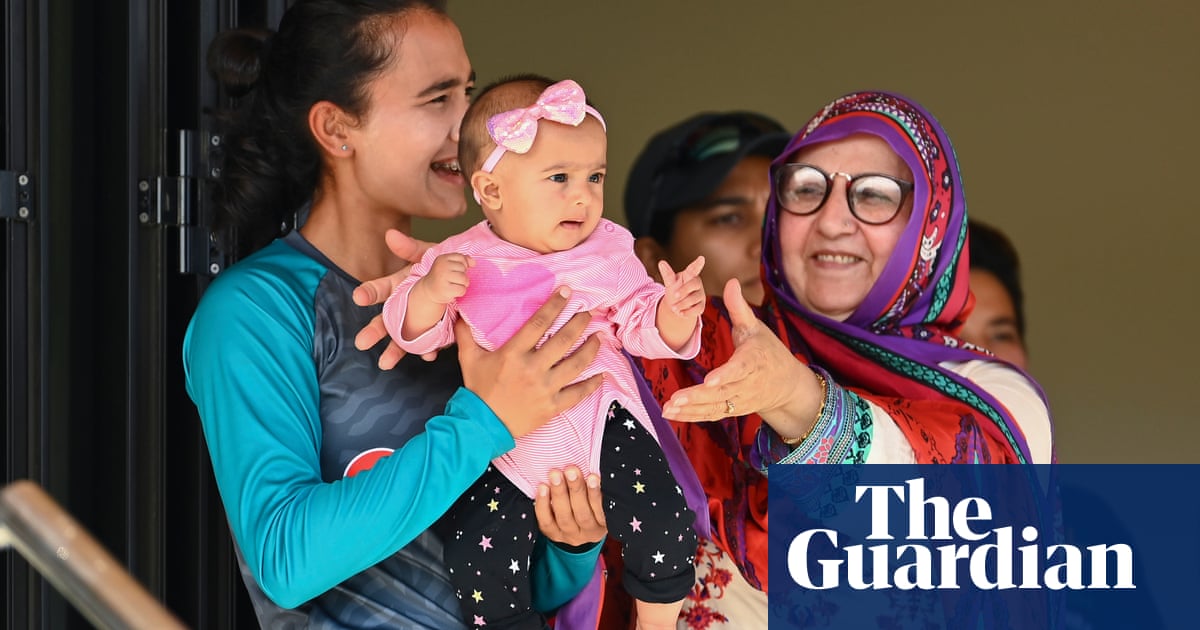The Spin | Pakistan’s Bismah Maroof radiates the power to inspire change in cricket - 5 minutes read

Fatima Maroof, centre, celebrates her mother's half-century for Pakistan against Australia from the pavilion at the Bay Oval. Photograph: Hannah Peters/ICC/Getty Images The Spin Pakistan’s Bismah Maroof radiates the power to inspire change in cricket Pakistan’s captain is back playing in the Women’s World Cup, having brought her six-month-old daughter Fatima with her
It is more than 33 years ago since Neneh Cherry swaggered around the Top of the Pops stage in big white trainers performing Buffalo Stance with the fierce energy of a woman who was having a fine old time and wanted everyone to know about it. Around her neck hung a huge medallion and she wore a golden bustier and matching jacket. But it wasn’t her outfit that was the talking point at secondary school the next day – but the seven-month pregnancy bump that stuck proudly out of her Lycra miniskirt as she lip-synched along.
It was the first time many of us had seen a pregnant woman being, well, visible and certainly the only time we’d seen one looking so sensationally cool. Allegedly, a journalist was daft enough to check with Cherry that it was safe for her to go on stage in her state of pregnancy, to which she sighed: “It’s not an illness.”
It was footage of the Pakistan captain, Bismah Maroof, holding her six-month-old daughter Fatima at the Women’s World Cup in New Zealand that instantly brought back memories of that Thursday night watching Cherry. Although Maroof was dressed in her pine-green Pakistan tracksuit and had her hair pulled back in a sportswoman’s ponytail, she radiated the same power to inspire change.
Seeing female cricketers with their children is not unknown, and there are eight mothers playing in the current World Cup – Maroof, New Zealand’s Amy Satterthwaite and her wife, Lea Tahuhu, West Indies’ Afy Fletcher, Australia’s Megan Schutt and Rachael Haynes, and Lizelle Lee and Masabata Klaas of South Africa – but it is practically unheard of on the subcontinent, where marriage and/or childbirth is usually the end for a cricketing career.
A fantastic article by Annesha Ghosh in The Cricket Monthly, looking at motherhood and cricket, summarises that only three of the 81 female cricketers contracted by India, Pakistan, Sri Lanka and Bangladesh are married. Maroof, then, is an outlier, not only leading her country but showing that motherhood does not have to spell the end to sporting ambition.
Maroof tells Ghosh that even during her own career, some of her teammates have had to give up the game: “Batool [Fatima], Nain [Abidi], Asmavia [Iqbal], Qanita [Jalil] and several others – they were all Pakistan teammates of mine who either couldn’t resume cricket for a long time after marriage or had to leave it altogether for good.”
However, the increased professionalism of the game over the past few years, and Maroof’s own pregnancy, nudged the Pakistan Cricket Board, during Wasim Khan’s spell as chief executive, into a maternity leave policy. This gives women a year’s paid leave (and men a month) plus shared costs of a support person to help with childcare – in this case Maroof’s mother, who has been seen cuddling Fatima in the stands.
The standout photos of Maroof and her baby came after the World Cup game between India and Pakistan on Sunday, won by India (therefore cementing their 100% record against Pakistan in one-day internationals). In them, members of the Indian team surround Maroof who is holding Fatima, cooing over the altogether cuteness of the baby in her red headband, playing peek-a-boo and trying to get her to look at the camera.
The sheer delight shared between the two teams is not something that is usually demonstrated between the Pakistan and Indian men’s teams, whose matches in international tournaments are often hijacked by politicians and fans and turned into some kind of ridiculous proxy war, often ending in violence, either in the stands or on the streets. The lower profile of the women’s matches, and the friendship between the players, has led to a far happier conclusion.
“Coming back post-pregnancy in six months and playing international cricket is so inspiring,” wrote Smriti Mandhana on Instagram. “Bismah Maroof setting an example for sportswomen across the globe. Lots of love to baby Fatima from India and I hope she picks the bat just like you because lefties are special.”
Despite the disparity in achievement between the two teams – India are ranked four and Pakistan eight – it is actually Pakistan who have taken the lead in franchise cricket, with Ramiz Raja, the Pakistan Cricket Board’s player-chairman, announcing a women’s branch of the Pakistan Super League to be played next year. Meanwhile the BCCI continues to stonewall on the possibility of a women’s Indian Premier League, with the secretary, Jay Shah, saying it would happen “soon”, despite the obvious talent pool of female cricketers and a ready supply of foreign players desperate to be part of the story.
But, in the hours after International Women’s Day, our thoughts should rest most with cricket-loving girls in Afghanistan, where the future of the women’s cricket team is still unclear, and most teenage girls have now gone 173 days without returning to school after the Taliban took over.
However, most of Afghanistan women’s team are believed to have fled the country and on the ACB website there are no photographs of any female players, no details of any upcoming women’s fixtures. In fact, no details on women’s cricket at all.
Source: The Guardian
Powered by NewsAPI.org